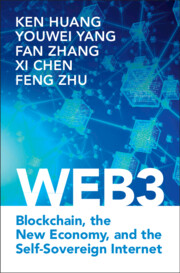3609 results

Web3
- Blockchain, the New Economy, and the Self-Sovereign Internet
- Coming soon
-
- Expected online publication date:
- August 2024
- Print publication:
- 31 August 2024
-
- Book
- Export citation
Electron backscatter diffraction (EBSD) study of elongatoolithid eggs from China with microstructural and parataxonomic implications
-
- Journal:
- Paleobiology , First View
- Published online by Cambridge University Press:
- 25 April 2024, pp. 1-16
-
- Article
- Export citation
Roles of TRP and PIEZO receptors in autoimmune diseases
-
- Journal:
- Expert Reviews in Molecular Medicine / Volume 26 / 2024
- Published online by Cambridge University Press:
- 25 April 2024, e10
-
- Article
-
- You have access
- Open access
- HTML
- Export citation
Phenomewide Association Study of Health Outcomes Associated With the Genetic Correlates of 25 Hydroxyvitamin D Concentration and Vitamin D Binding Protein Concentration
-
- Journal:
- Twin Research and Human Genetics , First View
- Published online by Cambridge University Press:
- 22 April 2024, pp. 1-11
-
- Article
-
- You have access
- Open access
- HTML
- Export citation
Effectiveness of GLIM and SGA for diagnosing malnutrition and predicting wound healing in patients with diabetic foot ulcers
-
- Journal:
- British Journal of Nutrition / Accepted manuscript
- Published online by Cambridge University Press:
- 18 April 2024, pp. 1-30
-
- Article
-
- You have access
- Export citation
The homotopy decomposition of the suspension of a non-simply-connected five-manifold
- Part of
-
- Journal:
- Proceedings of the Royal Society of Edinburgh. Section A: Mathematics , First View
- Published online by Cambridge University Press:
- 17 April 2024, pp. 1-29
-
- Article
- Export citation
Phylogenetic trends in TZ staining analysis of six deep dormancy seeds
-
- Journal:
- Seed Science Research , First View
- Published online by Cambridge University Press:
- 15 April 2024, pp. 1-13
-
- Article
-
- You have access
- Open access
- HTML
- Export citation
Bone-artefact production in late Neolithic central China: evidence from Pingliangtai
-
- Journal:
- Antiquity , First View
- Published online by Cambridge University Press:
- 15 April 2024, pp. 1-21
-
- Article
-
- You have access
- Open access
- HTML
- Export citation
Adult worm tegumental damage and egg-granulomas in praziquantel-resistant and -susceptible Schistosoma mansoni treated in vivo
-
- Journal:
- Journal of Helminthology / Volume 76 / Issue 4 / December 2002
- Published online by Cambridge University Press:
- 12 April 2024, pp. 327-333
-
- Article
- Export citation
A comprehensive study on the roles of viscosity and heat conduction in shock waves
-
- Journal:
- Journal of Fluid Mechanics / Volume 984 / 10 April 2024
- Published online by Cambridge University Press:
- 12 April 2024, A74
-
- Article
- Export citation
Theory of small-scale self-focusing of spatially partially coherent beams and its implications for high-power laser system
-
- Journal:
- High Power Laser Science and Engineering / Accepted manuscript
- Published online by Cambridge University Press:
- 11 April 2024, pp. 1-16
-
- Article
-
- You have access
- Open access
- Export citation
Mediterranean diet for cardiovascular disease: an evidence mapping study
-
- Journal:
- Public Health Nutrition / Accepted manuscript
- Published online by Cambridge University Press:
- 11 April 2024, pp. 1-22
-
- Article
-
- You have access
- Open access
- Export citation
Innovation in surgical treatment of hypertrophic obstructive cardiomyopathy in children
-
- Journal:
- Cardiology in the Young , First View
- Published online by Cambridge University Press:
- 11 April 2024, pp. 1-10
-
- Article
- Export citation
Individualised surgical treatment strategy for subaortic stenosis
-
- Journal:
- Cardiology in the Young , First View
- Published online by Cambridge University Press:
- 08 April 2024, pp. 1-8
-
- Article
- Export citation
Relationship between syncopal symptoms and head-up tilt test modes
-
- Journal:
- Cardiology in the Young , First View
- Published online by Cambridge University Press:
- 05 April 2024, pp. 1-6
-
- Article
- Export citation
Scaling regimes in rapidly rotating thermal convection at extreme Rayleigh numbers
-
- Journal:
- Journal of Fluid Mechanics / Volume 984 / 10 April 2024
- Published online by Cambridge University Press:
- 04 April 2024, A45
-
- Article
-
- You have access
- Open access
- HTML
- Export citation
Range inclusion and diagonalization of complex symmetric operators
- Part of
-
- Journal:
- Canadian Journal of Mathematics , First View
- Published online by Cambridge University Press:
- 04 April 2024, pp. 1-21
-
- Article
- Export citation
85 Investigations of Clinical and Translational Science Roadblocks: a Survey of a Private Medical School and a Large Public University
- Part of
-
- Journal:
- Journal of Clinical and Translational Science / Volume 8 / Issue s1 / April 2024
- Published online by Cambridge University Press:
- 03 April 2024, p. 23
-
- Article
-
- You have access
- Open access
- Export citation
Childhood maltreatment and resting-state network connectivity: The risk-buffering role of positive parenting
-
- Journal:
- Development and Psychopathology , First View
- Published online by Cambridge University Press:
- 02 April 2024, pp. 1-12
-
- Article
-
- You have access
- HTML
- Export citation

































